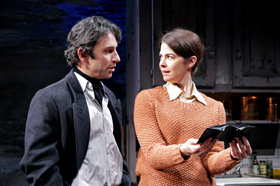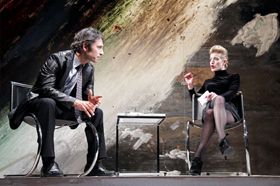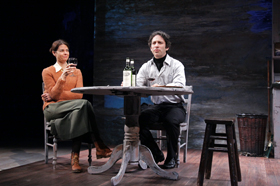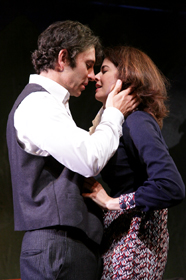
There are times when the order in which a writer sequences the scenes of a play or musical can be as crucial to the work’s impact as the scenes themselves. As in Harold Pinter’s Betrayal or Jason Robert Brown’s The Last Five Years, the ordering of scenes in Donald Margulies’ Sight Unseen is of prime importance. Cleverly sequenced in a deliberately non-linear fashion, the eight scenes that make up Sight Unseen keep you thinking, keep you guessing, and may even provoke a gasp of surprise or recognition at key moments.
 Sight Unseen now returns to South Coast Repertory, where it was commissioned and first staged just over twenty years ago, splendidly performed in 2012 by a stellar cast under the incisive direction of David Emmes.
Sight Unseen now returns to South Coast Repertory, where it was commissioned and first staged just over twenty years ago, splendidly performed in 2012 by a stellar cast under the incisive direction of David Emmes.
At the heart of Sight Unseen is a painting which all four of the play’s characters have seen (and which they discuss in some detail), but one which remains unseen by the audience, leaving it up to us to picture it in our mind’s eye, as we must also do with all of protagonist Nick Waxman’s (Gregory Sims) canvases, currently on display at a pricey London art gallery.
Sight Unseen takes place in four time frames. In 1974, 20ish co-ed Patricia (Nancy Bell) meets and poses for fledgling artist Jonathan. 1976 sees the couple breaking up after a two-year relationship. 1991 (the year of Sight Unseen’s World Premiere) has Jonathan visiting England for a retrospective of his work, a visit which includes an overnight stay at the Norfolk farmhouse where Patricia now lives with her archaeologist husband Nick (Andrew Borba). Four days later, Jonathan is in London being interviewed about the exhibition.
Told in this order, Sight Unseen would likely never have been nominated for the Pulitzer Prize, or jumpstarted Margulies’ playwriting career, or become a regional theater favorite. Fortunately, Margulies decided to play with time.
Scene One has Jonathan arriving at Nick and Patricia’s to a welcome that seems lukewarm at best. It’s only when we flash back in time that we find out the reasons for this less than open-armed welcome. Though we learn from the get-go that Nick is Jewish, married to a non-Jew, and expecting his first child (and that former girlfriend Patty was “the pioneer … the sacrificial shiksa”), it takes us till the end of Act One to find out—significantly—how Jonathan’s family reacted to this interfaith relationship.
 Scene Two introduces the play’s fourth and final character, icy blonde German journalist Grete (Erin Anderson), whose interview with Jonathan seems designed to push as many buttons as possible, raising questions about art and its meaning, art as a business, Jonathan’s Jewishness, and the importance of this Jewish identity in his work. Not surprisingly, things get prickly when talk between German and Jew turns to the Holocaust.
Scene Two introduces the play’s fourth and final character, icy blonde German journalist Grete (Erin Anderson), whose interview with Jonathan seems designed to push as many buttons as possible, raising questions about art and its meaning, art as a business, Jonathan’s Jewishness, and the importance of this Jewish identity in his work. Not surprisingly, things get prickly when talk between German and Jew turns to the Holocaust.
It’s fascinating to observe how cleverly Margulies plays with time in Sight Unseen. Scene Three gives us a glimpse of Patricia and Nick minutes before Jonathan’s arrival in Scene One, filling in a few blanks. Act One ends with Jonathan and Patricia’s breakup in 1976, at last revealing who broke up with whom and why. Two of Act Two’s four scenes continue Jonathan’s visit chez Patricia and Nick, interrupted by the second half of Grete’s interview with Jonathan, only now the eyes with which we view the painter have been altered by information from the previous three scenes. Finally, as in Betrayal and The Last Five Years, Sight Unseen shows us the couple’s first meeting, but with an entirely different perspective and reaction than would have been the case had this last scene come first, as a more traditionally structured play would have had it.
If this all sounds a tad complicated, it is indeed an approach requiring of an audience its raptest attention, but one that yields ample rewards.
 L.A.-based actors can once again rejoice that South Coast Rep casts its productions locally. Los Angeles may well be the world’s film and TV Mecca, but Anderson, Bell, Borba, and Sims are all consummate stage actors who can more than old their own against East Coast talents.
L.A.-based actors can once again rejoice that South Coast Rep casts its productions locally. Los Angeles may well be the world’s film and TV Mecca, but Anderson, Bell, Borba, and Sims are all consummate stage actors who can more than old their own against East Coast talents.
Audience sympathy in previous productions has apparently tended to be either in Jonathan’s corner or in Patricia’s. That Sims, Bell, and director Emmes manage to avoid tipping the scales too far in either direction is a tribute to the likability factor of each actor and to the depth and shadings each gives his or her character. Sims is a leading man we ought to be seeing much more of, a younger, rougher hewn Richard Gere who makes Jonathan’s appeal to Patricia quite palpable. SCR favorite Bell does equally fine work, and never more so than when we see Patricia at her youngest and most hopeful and vulnerable, before disillusion and resignation have set in. The chameleon-like Borba once again disappears into a character’s skin as he has done so many times before—at SCR, at the Pasadena Playhouse, and most recently in his hilarious work in La Mirada Theatre’s production of The 39 Steps. Norfolk accent, scruffy beard, and rumpled appearance combine to make us believe in this dull, stuffy archaeologist, though Borba soon shows us that still waters run deep. Anderson’s German accent, gelled blond hair, and angular beauty add up to a charismatic Weimaraner of an interviewer, and in fact it is her two scenes with Sims that may end up most vivid in your memory.
 Scenic designer Cameron Anderson has created a wondrously versatile set, one that reminds us at all times that we are seeing a play about an artist and about art. Fred Kinney’s costumes are a marvelous match for each character, particularly in the final scene in which Jonathan’s student garb transforms him instantly into a whole other version of the character we’ve been watching. Geoff Korf’s lighting design is both vivid and nuanced, as is Cricket S. Myers’ sound design. Jackie S. Hill is production manager and Kathryn Davies stage manager.
Scenic designer Cameron Anderson has created a wondrously versatile set, one that reminds us at all times that we are seeing a play about an artist and about art. Fred Kinney’s costumes are a marvelous match for each character, particularly in the final scene in which Jonathan’s student garb transforms him instantly into a whole other version of the character we’ve been watching. Geoff Korf’s lighting design is both vivid and nuanced, as is Cricket S. Myers’ sound design. Jackie S. Hill is production manager and Kathryn Davies stage manager.
Sight Unseen is the fifth Donald Margulies play I’ve seen, the others being Shipwrecked! An Entertainment, Dinner With Friends, Collected Stories, and Time Stands Still. If, like this reviewer, you’re seeing Sight Unseen for the first time, you’re in for a treat. Those who’ve seen it previously should find themselves equally rewarded the second time around.
South Coast Repertory, 655 Town Center Drive, Costa Mesa.
www.scr.org
–Steven Stanley
March 21, 2012
Photos: Scott Brinegar


 Since 2007, Steven Stanley's StageSceneLA.com has spotlighted the best in Southern California theater via reviews, interviews, and its annual StageSceneLA Scenies.
Since 2007, Steven Stanley's StageSceneLA.com has spotlighted the best in Southern California theater via reviews, interviews, and its annual StageSceneLA Scenies.







 COPYRIGHT 2024 STEVEN STANLEY :: DESIGN BY
COPYRIGHT 2024 STEVEN STANLEY :: DESIGN BY